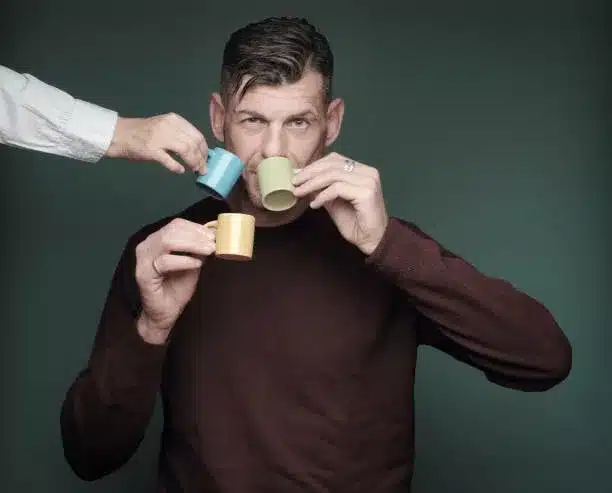I’m going to lay down the basics of why that morning cup of java holds such sway over your routine. Caffeine, my friend, is a central nervous system stimulant that doesn’t just perk you up; it sharpens your focus, turns up the dial on your metabolism, and even gives your mood a little lift.
Now what’s fascinating is that more than 90% of adults in the United States tap into this pick-me-up regularly. If you’re curious about numbers, we’re looking at an average of around 200 mg of caffeine per person per day. That’s roughly equivalent to two five-ounce cups of coffee or four sodas.
This isn’t just about a caffeine buzz; it’s also about understanding the wide-reaching effects that this stimulant has on our daily lives. With moderate consumption generally being safe, you might ask, ‘Where’s the line between a daily habit and addiction?’ That’s exactly what I’m here to explore with you.
Keep in mind, I’m not just tossing opinions here. This conversation is nested in years of research and observations. It’s a complex narrative that’s about to unfold. Next, we’re going to see how your very brain adapts to this common guest, potentially leading you to seek more and more to achieve the same effect.
The Brain on Caffeine: Adaptation and Tolerance

When you sip your morning coffee, you’re not just enjoying the taste – you’re triggering a cascade of chemical reactions in your brain. And it’s not just about that initial jolt of wakefulness. The story goes deeper; your brain actually adapts to your caffeine habit.
Caffeine’s primary move is to block your brain’s adenosine receptors. Adenosine is a neurotransmitter that promotes sleep and relaxation. Normally, it builds up during the day, making you increasingly sleepy. But caffeine swoops in and changes the game, blocking these signals and thus, increasing alertness and energy. The feeling of wakefulness is incredible, but here’s the kicker – your brain isn’t going to let caffeine win that easily.
Your brain is an adaptable organ. To compensate for the interference, it starts to produce more adenosine receptors, a classic move to maintain equilibrium. So, after a while, you need more caffeine just to achieve the same level of alertness. That, my friend, is tolerance in action.
Now think of this: each morning coffee is like laying a brick in the wall of caffeine tolerance. Over time, that wall gets higher, as you crave more caffeine to vault over it. It’s not sudden, and it’s not dramatic, but one day you may find a single espresso shot doesn’t cut it anymore; you want a double.
So, when does a habit turn into an addiction? Keep in mind that we’re navigating through a gray area here. The threshold is fuzzy, and the transition gradual. In the next section, I’m going to delve into the subtle yet influential distinction that separates habit from dependence and how society and the medical community differentiate between caffeine use and true addiction.
The Fine Line of Caffeine Addiction

This isn’t just about your morning jolt of energy; it’s also a closer look at the thin edge where habit can blur into dependency. Caffeine addiction is less about the buzz and more about the brain’s chemistry. Unlike substances that trigger severe addiction, caffeine stimulates the brain’s reward system more gently. But does that make it less of an addiction?
Let’s take a moment to understand where the experts stand. The American Psychiatric Association (APA) does not classify caffeine addiction in the same category as other Substance Use Disorders. However, they’ve taken note of the withdrawal symptoms that present themselves when one pares back on caffeine. It’s clear evidence that the body can become reliant on that coffee fix.
I’m going to tell you about the World Health Organization’s (WHO) viewpoint, which marked a significant moment back in 2012. They recognized caffeine addiction as a clinical disorder, a nod to the fact that caffeine’s grip can be as real as any other addictive substance, even if less intense.
Coming to the Diagnostic and Statistical Manual of Mental Disorders, Fifth Edition (DSM-5), caffeine hasn’t quite made it to the ranks of Substance Use Disorder yet, but it remains on the radar. It’s classified as a condition for further study, with the DSM-5 outlining criteria to identify problematic caffeine use. What’s clear is that there’s a growing understanding of caffeine’s potential for addiction.
You can always adjust your approach down the road, but these perspectives suggest we reconsider how we view our daily caffeine rituals. In my opinion, the controversy surrounding caffeine addiction needs respectful attention from both the public and scientific communities.
Recognizing Caffeine Dependence: Symptoms and Impact

I’m going to outline how you can identify if you’re edging toward caffeine dependence, and let me tell you, the signs can be more subtle than you’d expect. It starts with noticing a persistent desire to cut down on your coffee or energy drink intake. You tell yourself you’ll lay off the espresso shots, yet somehow, you find yourself standing in line at your favorite coffee shop, day after day.
Now what’s troubling is when you continue using caffeine even when you know it’s causing trouble. Say, for instance, it messes with your sleep or gives you jitters, but the thought of not having your caffeine fix seems unimaginable.
Withdrawal symptoms are another tell-tale sign. They can sneak up on you, and before you know it, you’re grappling with headaches, irritability, and a noticeable dip in energy levels. These symptoms can start within 24 hours of your last caffeine fix and are a clear indicator that your body’s not just craving, it’s depending.
Caffeine tolerance is also something to watch out for. When you find yourself upping the number of cups just to get the same level of alertness, it’s time to pause and reassess.
All these factors can snowball, having a significant impact on your daily life. You might find your coffee habit is taking a toll on your finances, or becoming an obstacle in managing your responsibilities effectively.
Choose something that resonates with you when considering your relationship with caffeine. If you suspect your caffeine consumption is starting to border on dependence, it’s essential to start thinking about how to tackle it – that leads nicely into the next part of our discussion, which is about managing your caffeine intake responsibly.
Navigating Safely: Recommended Caffeine Consumption

If you want to maintain a healthy relationship with caffeine, it’s important to be aware of how much you’re consuming. You might be surprised to learn that experts recommend no more than 400 mg of caffeine per day for adults. That’s roughly equivalent to four small cups of brewed coffee.
Now, why does this matter? Well, consistently exceeding this amount can lead to a host of negative side effects. And we’re not just talking about the jitters. I’m referring to issues such as insomnia, digestive problems, increased heart rate, muscle tremors, and even anxiety.
That’s going to include making some conscious choices about your caffeine intake. For example, watch out for hidden sources of caffeine like certain sodas, energy drinks, and even some medications. Combine these with your daily coffee, and you might inadvertently go over the recommended limit.
You can always adjust your approach down the road, but it helps to start with moderation. Choose something that resonates with you. Whether it’s mixing decaf with regular coffee, opting for smaller servings, or setting specific ‘caffeine-free’ periods during your day, any step towards controlling intake is a step in the right direction.
What resonates with me is the idea that by keeping within these guidelines, most people can enjoy the benefits of caffeine without the negative consequences. Don’t worry too much if you’ve had a heavy caffeine day once in a while, but be mindful if it’s becoming a regular occurrence.
Breaking the Habit: Coping with Caffeine Withdrawal
The 15 Absolute Best Gifts for Coffee Lovers This Holiday Season
I’m here to help you with understanding what happens when you decide to cut back on caffeine. It’s about recognizing that those headaches, irritability, and fatigue are all part of a normal process. Once you stop reaching for that morning cup of Joe or afternoon energy drink, your body will likely react. And guess what? Those symptoms can kick in within 24 hours of your last caffeine fix and linger for over a week.
But here’s the good news: You can manage these symptoms effectively. Gradually reducing caffeine consumption is key to minimizing discomfort. Instead of going cold turkey, try cutting down the amount you consume little by little. This smoother transition allows your body to adjust at a gentler pace, resulting in fewer withdrawal effects.
And if you’re wondering how long this process takes, I’ve got some numbers for you. Most people who reduce their intake begin to see an improvement in withdrawal symptoms within 7 to 12 days. That’s not so long, considering the long-term benefits of breaking free from caffeine dependency.
Ultimately, you’ll want to listen to your body. Choose something that resonates with you; maybe switch to decaf options or caffeine-free herbal teas. Remember, your first attempt doesn’t need to be your last. Adjust your approach down the road if needed, and don’t worry too much about the occasional slip-up. It’s all part of the journey towards better health and well-being.
In a family of coffee addicts, Mark started to appreciate the drink fairly late – around 35 years old.
His love for java began when he wrote articles on it and bought his first machine after which everything else just fell into place; there are now five machines in our home!
We start every day with an early morning cuppa coffee because what could better help set your mind right than some freshly brewed hot Coffee?
When Marks not writing or thinking about coffee, he can be found sipping on a cup of black gold at one of his favorite local joints.




